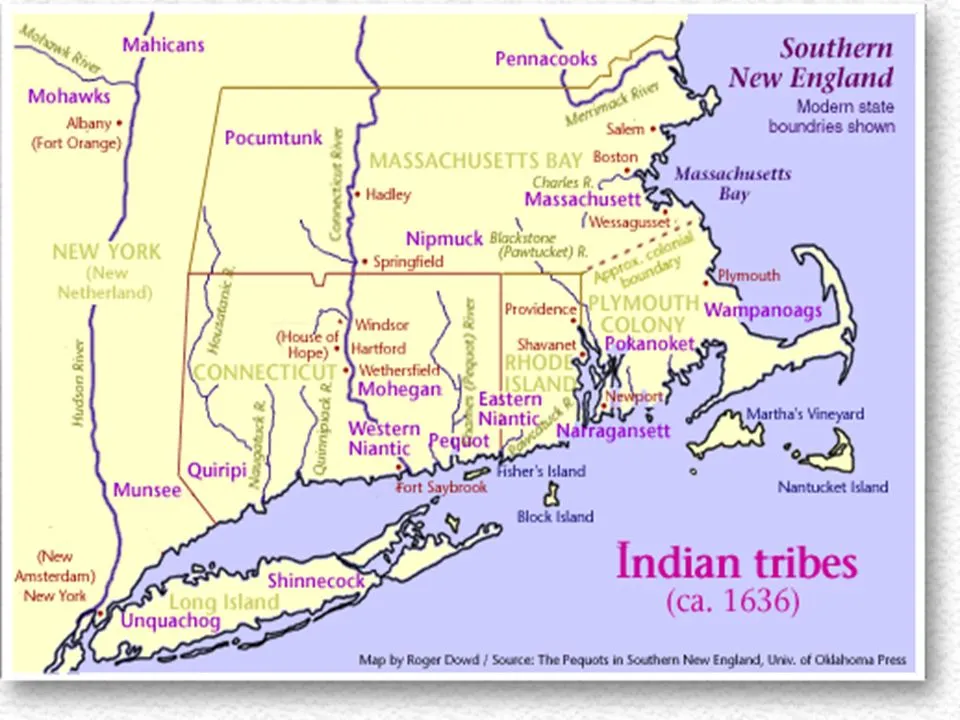Embark on a captivating journey through history with https://oavintage.com/ about Native American Map of New England. This meticulously detailed map unveils the ancestral territories and cultural landscapes of the Indigenous peoples who have inhabited New England for centuries.
Explore the rich tapestry of Native American heritage, from the Abenaki to the Wampanoag Nations, and discover the profound connection between these tribes and the land they call home. Immerse yourself in the vibrant history of New England’s Indigenous communities with our Native American Map of New England.
The Native American Map Of New England
Step back in time to the early days of the English colonies in North America with the “Map of New England,” a groundbreaking piece of cartographic history. Crafted by John Foster, a Boston-based printer renowned for his woodcutting skills, this map is not only a testament to colonial ingenuity but also a window into the past of the Western Hemisphere’s cartography.
Colonial Cartography: An Unprecedented Feat
Published in conjunction with William Hubbard’s “Narrative of the Troubles with the Indians,” this map holds the distinction of being the first-ever map documented in the English colonies. It serves as a pioneering achievement in the annals of Western Hemisphere cartography.
The Unique Layout: A Glimpse into Early Mapping
At first glance, the map’s layout may appear somewhat disorienting to modern researchers. It presents the western expanse of New England along the top of the page, while the northern regions, including the White Hills of what we now know as New Hampshire, are depicted along the right side.
The Controversy: Two Versions, One Mystery

A compelling enigma surrounds this historic map. Another version, potentially also crafted by John Foster in Boston, found its way into the London edition of Hubbard’s work, titled “The Present State of New-England.” The distinguishing feature between the two versions lies in the text inscribed on the map. In the American edition, it is referred to as the “White Hills” map, whereas in the other, the White Hills of New Hampshire are labeled as the “Wine Hills.”
A Century-Long Puzzle: Unraveling the Enigma
For over a century, bibliographers, historians, and map collectors have grappled with the intricate questions surrounding these maps. They have strived to ascertain the sequence of printing and whether both maps were indeed the handiwork of John Foster. While some mysteries endure, it is irrefutable that the Historical Society’s copy of the “White Hills” map is a singular artifact, featuring a symbol for an unnamed town not found in any other surviving copy of this version.
A Unique Perspective: Navigating the “Map of New England”
With its northward orientation, the map invites exploration, leading us into the past. An inscription in the upper right corner narrates its historical significance: “A MAP OF NEW-ENGLAND, Being the first that ever was here cut, and done by the best Pattern that could be had, which being in some places defective, it made the other less exact: yet doth it sufficiently shew the Scituation of the Country, and conveniently well the distance of Places. The figures that are joyned with the Names of Places are to distinguish such as have been assaulted by the Indians from others.”
Unlocking the Treasures of Colonial Cartography
As we delve into the “Map of New England,” we unearth an invaluable relic of colonial exploration and discovery. Join us on this historical journey as we unravel the mysteries concealed within this remarkable piece of cartographic heritage.
Read more interesting things about native american people Native American Turtle Island Map
What Native American tribe lived in New England?
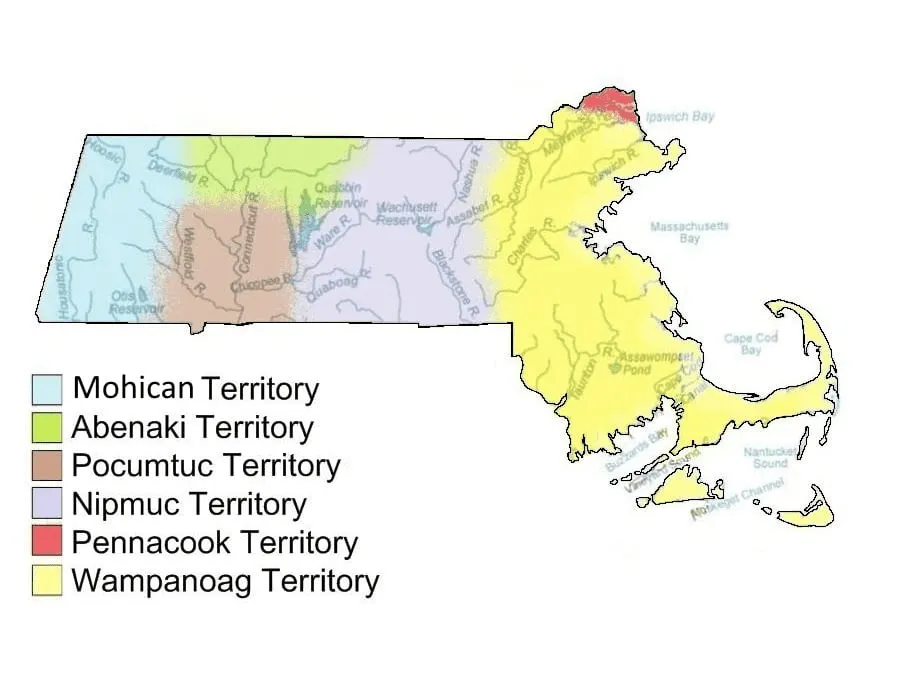
In the annals of American history, New England stands as a region teeming with stories of exploration, settlement, and cultural exchange. However, long before the first European settlers laid eyes on its shores, New England was already a thriving land, home to a diverse array of Native American tribes.
A Multitude of Nations: The Indigenous Tapestry
Experts estimate that at the dawn of the 17th century, New England was inhabited by a substantial population of Native Americans, ranging between 70,000 to 100,000 individuals. These indigenous communities were an integral part of the larger Algonquian cultural group, sharing not only a linguistic connection but also a rich tapestry of traditions.
Within this mosaic, numerous distinct tribes flourished, each contributing to the vibrant fabric of New England. Among these were the Abenaki, Micmac, Pennacook, Pequot, Mohegan, Nauset, Narragansett, Nipmuc, Woronoco, and Wampanoag peoples.
Life in New England: Nurtured by the Land
The Native American communities of New England crafted their lives in harmony with the land. In the southern regions, where fertile soil allowed for agriculture, women skillfully tended fields of corn, beans, and squash. Meanwhile, men complemented their diet by fishing and hunting. Beneath the sheltering canopy of New England’s lush forests, women and children gathered nuts and berries, sustaining their communities with nature’s bounty.
A Tale of Resilience and Trade
In the northern reaches of New England, where the climate proved less accommodating to agriculture, Native Americans relied on fishing, hunting, gathering, and trade. As early as the 1600s, these indigenous peoples initiated trade relations with European merchants, exchanging prized beaver pelts for metals and textiles.
However, along with valuable goods, European contact brought unforeseen devastation. Native Americans, lacking immunity, were ravaged by deadly diseases. In 1616, a devastating epidemic swept through, claiming the lives of an estimated 75 percent of Native Americans along the Atlantic Coast of New England.
Nomadic Life and Land Ownership: A Different Perspective
The villages of New England’s tribes were typically semipermanent. When the land’s fertility waned, these communities would relocate to neighboring areas. This distinctive way of life held contrasting views on land ownership when compared to the European settlers who would later encroach upon Native American territories.
The Arrival of the Pilgrims: A Fateful Encounter
In the winter of 1620, the first Europeans set foot in New England, seeking refuge and a new beginning. These intrepid travelers, known as the Pilgrims, hailed from England and established themselves in Plymouth, Massachusetts. This historic moment is believed to have unfolded on the grounds of a former Pawtuxet village, decimated by disease.
The Providential Encounter: Squanto’s Role
Within this providential encounter, a pivotal figure emerged—Squanto, a Pawtuxet tribesman who had been kidnapped by a European captain and taken to England. Remarkably, he managed to secure his freedom and return to his homeland.
Squanto’s presence proved invaluable to the Pilgrims, as he shared vital knowledge of corn cultivation, fishing techniques, and hunting grounds. Moreover, his linguistic skills facilitated communication between the English settlers and the native tribes, fostering negotiation and peace.
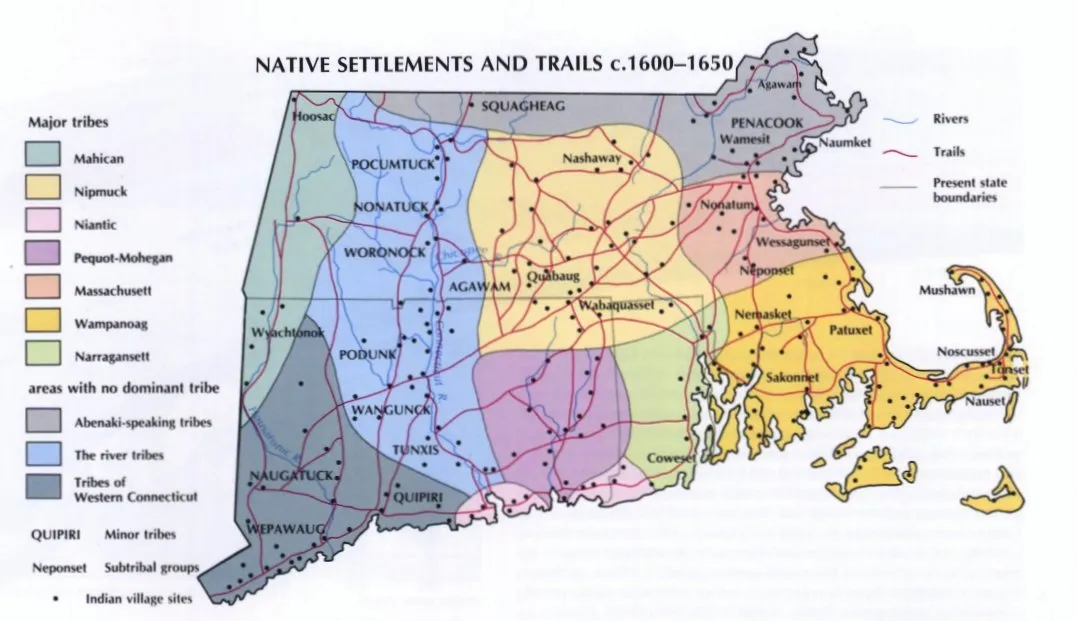
Fragile Peace and Turbulent Times
Yet, peace remained an elusive prize. In the ensuing decades, conflicts between English settlers and Native Americans flared frequently. Waves of newcomers sought to lay claim to lands already inhabited, intensifying competition over trade.
The Pequot War of 1636-1637 witnessed the destruction of Pequot villages and the loss of thousands of lives. In 1675, the Native American coalition, led by Pokunoket Chief Metacom, embarked on a desperate struggle to safeguard their territory and honor.
However, they were ultimately outnumbered and overwhelmed by the ever-growing influx of European settlers. This tumultuous period, known as King Philip’s War, marked the final significant endeavor of Native Americans to resist English encroachment upon New England.
A Legacy Unveiled: Exploring New England’s Indigenous Roots
As we delve into the annals of New England’s history, we uncover a profound tapestry of indigenous cultures and encounters that continue to shape the region’s identity. Join us in a journey of discovery, where the vibrant heritage of New England’s Native American communities comes to life, offering a deeper understanding of this captivating corner of America.
Are there Native Americans in New England?
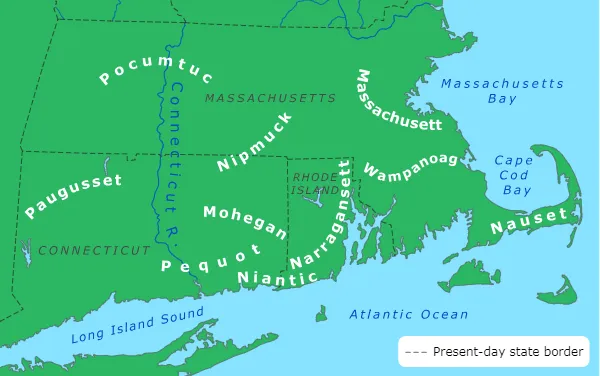
In the heartland of Massachusetts, northeastern Connecticut, and northwestern Rhode Island, a resilient tribal group known as the Nipmuc Indians has woven the fabric of their culture for centuries. Today, we delve into the captivating history and heritage of the Nipmuc Nation, a state-recognized band with a remarkable journey that spans generations.
Hassanamisco Reservation: A Sanctuary of Continuity
Nestled in the town of Grafton, Massachusetts, lies the sacred Hassanamisco Reservation. Covering a modest expanse of 3 acres, this reservation stands as a testament to the unwavering connection of the Nipmuc people to their ancestral lands. What makes this parcel truly exceptional is its unbroken lineage of Nipmuc occupancy, dating back to a time before the arrival of European explorers and settlers.
A Glimpse Into the Present: The Nipmuc Nation Today
Today, the Nipmuc Nation thrives with approximately 500 enrolled members. These dedicated individuals carry the torch of their ancestors, preserving the cultural legacy that defines the Nipmuc identity. The Hassanamisco Reservation remains a vital hub for the Nipmuc community, serving as a living testament to their enduring bond with the land.
A Tapestry of Communities: The Bands of Nipmuc
Within the Nipmuc Nation, various bands have emerged, each contributing to the diverse mosaic of Nipmuc culture. Among these are the Chaubunagungamaug, nestled in the town of Webster, and the Natick Nipmuc, who call Natick their home. These bands represent vibrant branches of the Nipmuc family tree, each with its unique stories, traditions, and contributions.
Honoring the Past, Shaping the Future
As we explore the rich tapestry of the Nipmuc Indians, we encounter a community deeply rooted in their ancestral lands and committed to preserving their cultural heritage. The Nipmuc Nation’s journey from the distant past to the present day is a testament to their resilience, determination, and unwavering connection to the land they call home.
Join us in celebrating the enduring legacy of the Nipmuc Indians, the keepers of ancient lands and guardians of a vibrant culture.
What happened to the Native Americans of New England?

Approximately 11,000 years ago, a group of people embarked on a journey into the unknown, eventually arriving in what is now known as the New Hampshire region. Over time, the complexities of history and human migration have shrouded the exact origins of these early inhabitants. These resilient pioneers, whose legacy endures to this day, became the ancestors of the Abenaki people.
The Abenaki Mosaic: Tribes and Dialects
Within the tapestry of the Abenaki heritage, these early inhabitants organized themselves into distinct bands, often referred to as tribes. Among these were the Penacook, Winnipesaukee, Pigwacket, Sokoki, Cowasuck, and Ossipee, each sharing a common thread—the Abenaki language. This rich linguistic tradition wove their communities together, fostering unity and shared identity.
People of the Dawnland: Unveiling the Abenaki
Collectively known as the Abenaki, these resilient individuals drew their name from their language. “Abenaki” is often translated as “People of the Dawnland,” a reflection of their profound connection to the natural world. In their language, “woban” signifies daybreak, while “ski” represents the earth or land, beautifully encapsulating their deep-rooted relationship with their homeland.
Lives Shaped by Nature: Abenaki Traditions
The Abenaki way of life was closely intertwined with the rhythms of nature. They did not claim ownership of the land but instead respected and utilized it in harmony with their customs, the changing seasons, and the demands of daily life. Villages were strategically established along rivers and lakes, providing access to vital resources like water, fish, and game.
The Waterways of Plenty: Abenaki Fishing Traditions
Fishing was a cornerstone of Abenaki life, and they crafted intricate traps known as weirs to harvest the bounty of their rivers and lakes. Legendary fishing spots near the majestic waterfalls of the Merrimack, Connecticut, Saco, and Androscoggin Rivers, as well as iconic locations like Amoskeag Falls and the Weirs at Lake Winnepausakee’s mouth, bore witness to the yearly spectacle of shad, salmon, and alewife migrations.
Challenges and Resilience: Abenaki in the Face of Adversity
The late 1600s brought a period of profound challenges for the Native American population in New Hampshire. The arrival of European settlers introduced devastating diseases, such as smallpox and influenza, against which the Abenaki had no immunity.
Major epidemics between 1615 and 1620 decimated their communities. Concurrently, conflicts with the invading Mohawk and disputes with European settlers over ownership of Abenaki ancestral lands added to their hardships.
The Unbroken Thread: Abenaki Legacy and Language Revival
Despite the trials they faced, the Abenaki people’s resilience endures. By the end of the 17th century, many Abenaki individuals had integrated into European settler communities or had migrated to Canada, specifically to the village of St. Francis in Quebec, known as Odanak.
Today, less than 1,000 Abenaki call New Hampshire home, with only a handful fluent in their ancestral language. In 1995, Joseph Laurent, an Abenaki born in Odanak who later resettled in Intervale, NH, completed a monumental 30-year project—the translation of “Father Aubery’s French Abenaki Dictionary.” This vital endeavor stands as a testament to their commitment to preserving the beauty and heritage of the Abenaki language for future generations.
Celebrating Abenaki Resilience: Guardians of the Dawnland
The Abenaki people, as the guardians of the Dawnland, continue to shape their destiny with resilience and pride. Their journey, rooted in ancient traditions and enduring heritage, is a testament to the strength of the human spirit in the face of adversity. Join us in celebrating the Abenaki legacy, a cherished chapter in the story of New Hampshire’s history.
How many Native Americans live in New England?
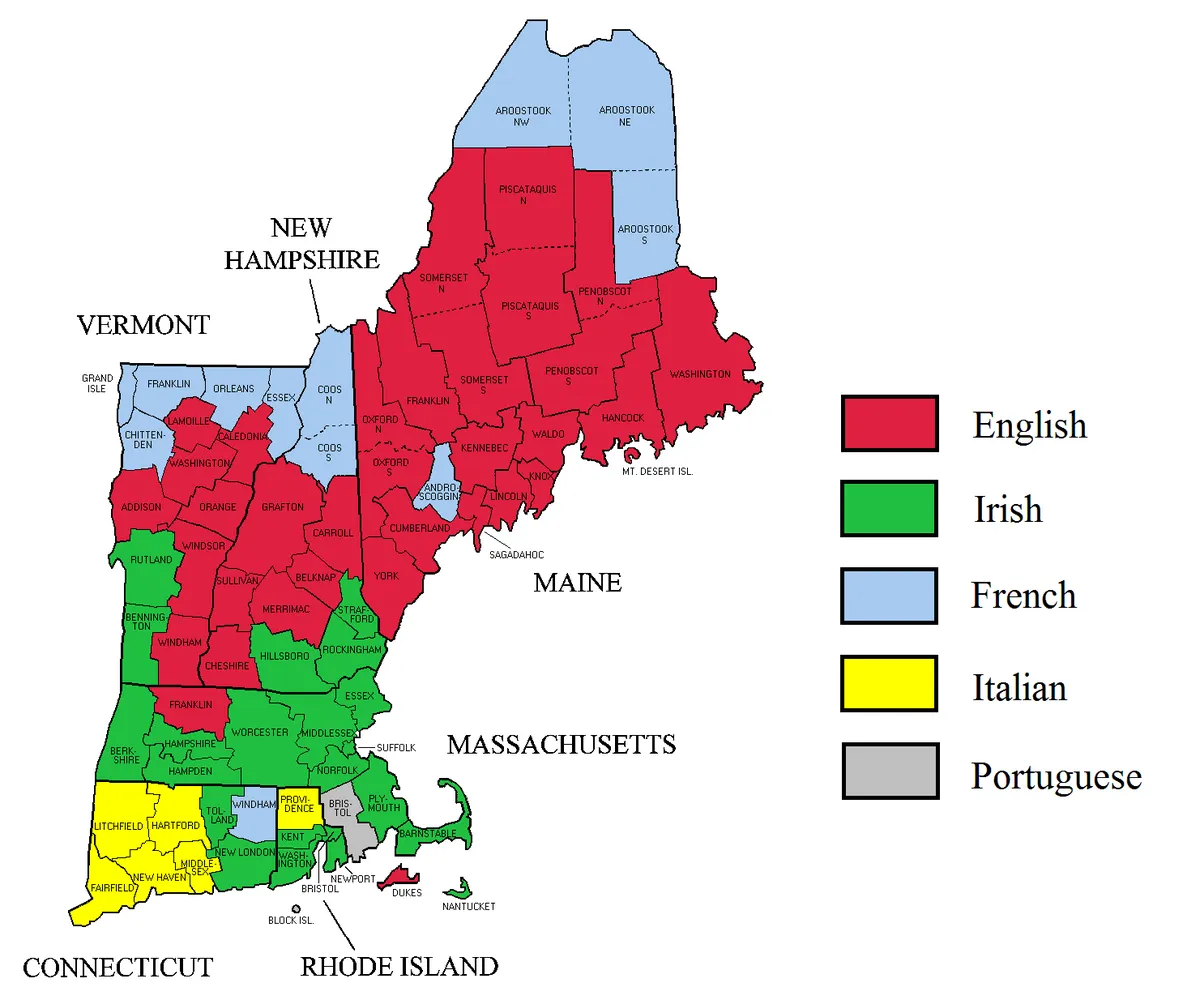
New England, a captivating region of the United States, is not only steeped in history and natural beauty but is also home to a remarkably diverse population. According to the 2018 American Community Survey, let’s delve into the intricate fabric of New England’s demographics, uncovering a wealth of ethnicities, races, and ancestries that collectively contribute to its vibrant cultural landscape.
Population Overview: Balancing Genders and Generations
At the heart of New England’s demographics lies a population of approximately 14,853,290 individuals. Maintaining a near-perfect equilibrium, the region is divided almost evenly between genders, with 48.7% identifying as male and 51.3% as female. A dynamic blend of generations exists, with 19.7% under the age of 18 and 17.4% aged 65 or older.
A Mosaic of Racial and Ethnic Identities: The Face of New England
New England proudly wears the mantle of diversity, with a rich tapestry of racial and ethnic identities.
- White Americans: The majority, comprising 80.7% of the population, with 74.4% identifying as non-Hispanic Whites.
- Black Americans: Forming 7.1% of the region’s inhabitants, including 6.4% non-Hispanic Black individuals.
- Native Americans: A resilient community, constituting 0.3% of the population, totaling 43,917.
- Asian Americans: Flourishing in New England, with over 650,000 individuals, making up 5.0% of the population.
- Chinese Americans: A prominent subset of the Asian American community, numbering over 240,000, or 1.6% of the total population.
- Indian Americans: Contributing significantly to the regional diversity, with over 212,000 individuals, representing 1.4% of the population.
- Pacific Islander Americans: A smaller yet vibrant community, comprising 0.04% of the populace.
A Unique Demographic Landscape: New England’s Diversity
Intriguingly, New England stands as one of the few regions in the United States where recent Black immigrants surpass Black individuals of multigenerational American origin, with a ratio of 60 to 40. The Haitian community thrives in the Boston metropolitan area, while Jamaican immigrants have found a home in Connecticut, particularly around Hartford.
A Tapestry of Origins: African Groups
Within New England, various African groups have established vibrant communities. This includes Liberians and Cape Verdeans, particularly prominent in Boston and Providence. Additionally, individuals from diverse parts of West Africa have made their homes in the Boston area, southwest Connecticut near New York City, and Worcester, Massachusetts. The regions of Boston metropolitan area, Northern Rhode Island, and Southwest Connecticut emerge as the most ethnically diverse corners of New England.
Celebrating Multiracial Identities: A Harmonious Blend
Multiracial Americans constitute 3.1% of New England’s population, reflecting the fusion of diverse heritages. Notably, people of African and European descent form the largest mixed-race group, with over 171,000 individuals comprising 1.2% of the population. Additional categories include individuals of mixed Native American and European American ancestry (0.4%) and those of Asian and European heritage (0.6%).
Hispanic/Latino Heritage: A Vibrant Community
Hispanic and Latino Americans are a vibrant and significant minority in New England, second in number only to non-Hispanic European Americans. Comprising 11.4% of the population, nearly 1.7 million Hispanic and Latino individuals contribute to the rich cultural mosaic of the region.
- Puerto Ricans: The largest subgroup, with over 710,000 individuals, forming 4.8% of the population.
- Dominicans: A substantial community, numbering over 281,000, or 1.9% of New England’s population.
- Mexican Americans: Nearly 137,000 individuals, adding to the diverse Hispanic/Latino tapestry.
Regional Nuances: Southern and Southwestern New England
Southern New England, encompassing Rhode Island and eastern Massachusetts, boasts a Dominican plurality among its Hispanic/Latino community. Rhode Island, in particular, claims the highest percentage of Dominicans of any U.S. state. Southwestern New England, consisting of Connecticut and western Massachusetts, presents a Puerto Rican majority among its Hispanic/Latino community. Cities like Springfield, Holyoke, Hartford, New Haven, and Bridgeport lead the nation in percentages of Puerto Ricans, with Connecticut ranking highest among U.S. states.
European American Diversity: A Blend of Ancestries
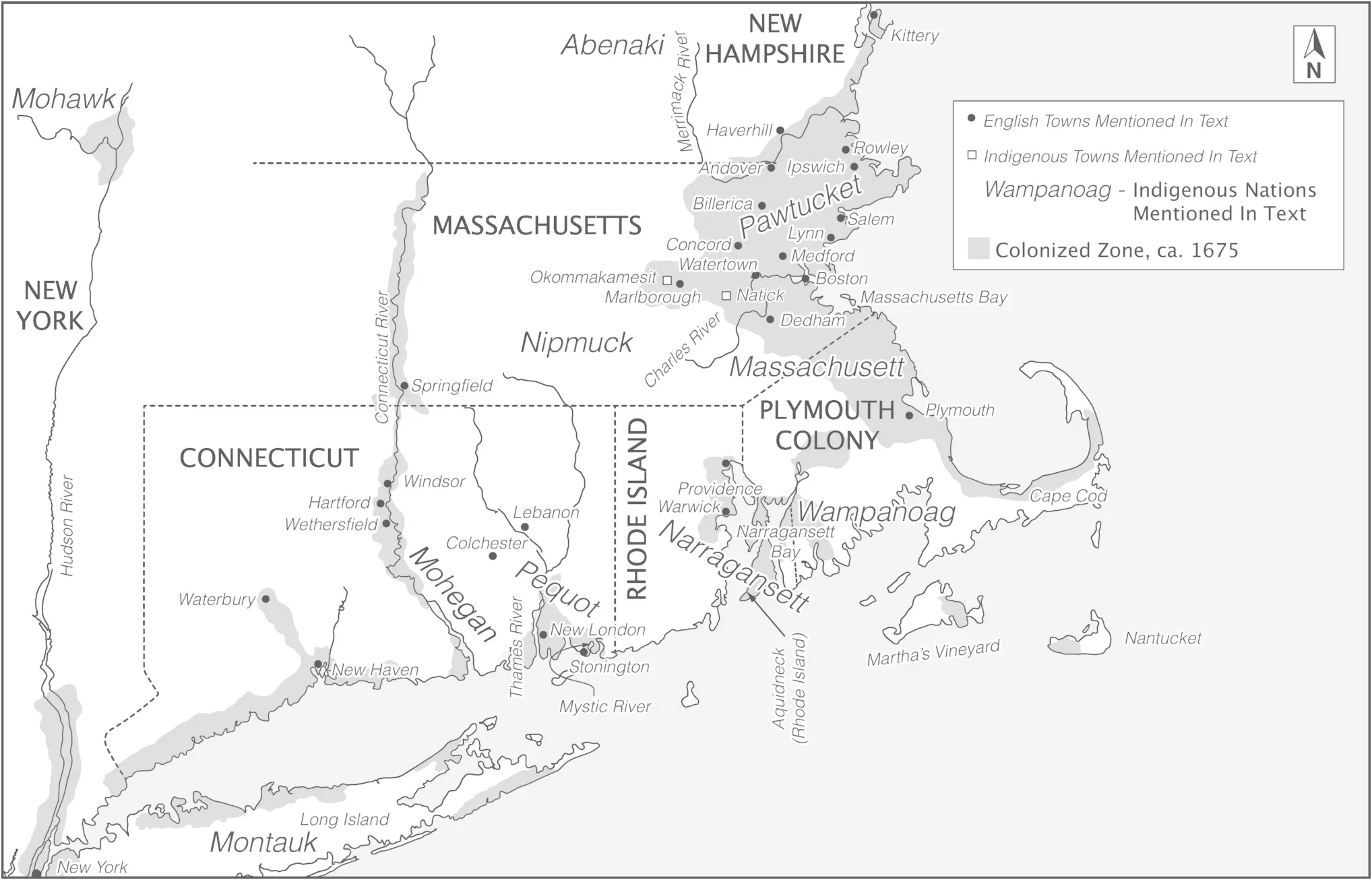
New England’s European American population showcases a delightful ethnic diversity, including Irish, Italian, French, English, German, Polish, Portuguese, Scottish, Swedish, and Russian ancestries. Irish and Italian populations are especially prominent, with Rhode Island standing out as having the highest percentage of these groups in the United States, particularly in its southern half.
Survey Insights: Top Ten European Ancestries in 2018
- Irish: 17.5% (2.6 million)
- English: 15.0% (2.2 million) (includes “American” ancestry)
- Italian: 12.3% (1.8 million)
- French or French Canadian: 11.5% (1.7 million)
- German: 6.5% (966,000)
- Polish: 4.6% (676,000)
- Portuguese: 3.0% (441,000)
- Scottish: 2.4% (348,000)
- Swedish: 1.5% (226,000)
- Russian: 1.2% (175,000)
Embracing Diversity: The Essence of New England
Intricate and diverse, New England’s demographic mosaic reflects a beautiful blend of cultures, ethnicities, and histories. From historic European American communities to vibrant Hispanic/Latino populations and burgeoning Asian communities, New England’s rich diversity is a testament to the region’s ever-evolving identity.

